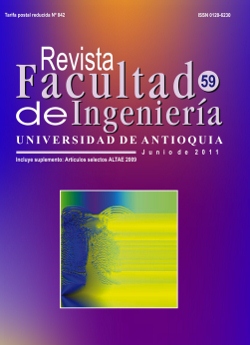Semantic assessment of similarity between raster elevation datasets
DOI:
https://doi.org/10.17533/udea.redin.13753Keywords:
semantic similarity, DEM, ontology, geomorphometric analysis, GISAbstract
This paper describes a method to assess the similarity between digital elevation models (DEM), based on the comparison of the landforms. The method attempts to mimic the one commonly used by human beings, which consists of comparisons among the shapes that a human subject identifies in the landscape. To do so, semantic similarity measurements are applied over a hierarchy of concepts. Our method is composed of two stages: the Geomorphometric Analysis and the Semantic Analysis. The first stage aims to represent the topographic properties using one of the concepts of the hierarchy, depending on an analysis of the DEM. The second stage consists of comparisons among the concepts that characterize the landscape using a measure of semantic similarity. In this stage, two levels of semantic analysis are defined: local and global. The advantage of our method is that the interpretation of the results is simplified by means of a semantic processing.
Downloads
References
D. Sheeren, S. Mustière, J. D. Zucker. “A datamining approach for assessing consistency between multiple representations in spatial databases”. Int. J. of Geographical Information Science. Vol. 23. 2009. pp. 961- 992. DOI: https://doi.org/10.1080/13658810701791949
P. Fisher, A. Comber, R. Wadsworth. “What’s in a name? Semantics, standards and data quality”. R. Devillers, H. Goodchild. (editors). Spatial data quality. From process to decisions. Ed. CRC Press. Boca Raton. 2010. pp. 2-16. DOI: https://doi.org/10.1201/b10305-3
H. T. Uitermark, P. J. van Oosterom, N. J. I. Mars, M. Molenaar. “Ontology-based integration of topographic data sets”. Int. J. of Applied Earth Observation and Geoinformation. Vol. 7. 2005. pp. 97-106. DOI: https://doi.org/10.1016/j.jag.2005.03.002
J. M. Sappington, K. M. Longshore. “Quantifying Landscape Ruggedness for Animal Habitat Analysis: A Case Study Using Bighorn Sheep in the Mojave Desert”. J. of Wildlife Management. Vol. 71. 2007. pp. 1419-1426. DOI: https://doi.org/10.2193/2005-723
O. Z. Chaudhry, W. A. Mackaness. “Creating Mountains out of Mole Hills: Automatic Identification of Hills and Ranges Using Morphometric Analysis”. Transactions in GIS. Vol. 12. 2008. pp. 567-589. DOI: https://doi.org/10.1111/j.1467-9671.2008.01116.x
E. R. Venteris, B. K. Slater. “A Comparison between Contour Elevation Data Sources for DEM Creation and Soil Carbon Prediction, Coshocton, Ohio”. Transactions in GIS. Vol. 9. 2005. pp. 179-198. DOI: https://doi.org/10.1111/j.1467-9671.2005.00212.x
S. Clarke, K. Burnett. “Comparison of Digital Elevation Models for Aquatic Data Development”. Photogrammetric Engineering & Remote Sensing. Vol. 69. 2003. pp. 1367-1375. DOI: https://doi.org/10.14358/PERS.69.12.1367
S. J. Riley, S. D. De Gloria, R. Elliot. “A terrain ruggedness index that quantifies topographic heterogeneity”. Intermountain J. of Sciences. Vol. 5. 1999. pp. 23-27.
M. Moreno-Ibarra. “Semantic Similarity Applied to Generalization of Geospatial Data”. Lecture Notes in Computer Science. Vol. 4853. 2007. pp. 247-255. DOI: https://doi.org/10.1007/978-3-540-76876-0_16
R. Quintero. Representación Semántica de Datos Espaciales Raster. Tesis Doctoral. Instituto Politécnico Nacional. 2007. pp. 77-108.
R. Quintero, M. Torres, M. Moreno, G. Guzmán G. “Metodología para generar una Representación Semántica de Datos Raster”. T. Delgado, J. Capote (editors). Semántica espacial y descubrimiento de conocimiento para desarrollo sostenible. Ed. CUJAE. La Habana. 2009. pp. 119-145.
S. A. Sloman, B. C. Love, A. Woo-Kyoung. “Feature centrality and conceptual coherence”. Cognitive Science. Vol. 22. 1998. pp. 189-228. DOI: https://doi.org/10.1016/S0364-0213(99)80039-1
A. Rodriguez, M. Egenhofer. “Comparing Geospatial Entity Classes: An Asymmetric and Context- Dependent Similarity Measure”. Int. Journal of Geographical Information Science. Vol. 18. 2004. pp. 229-256. DOI: https://doi.org/10.1080/13658810310001629592
K. Janowicz, C. Keßler, M. Schwarz, M. Wilkes, I. Panov, M. Espeter, B. Bäumer. “Algorithm, Implementation and Application of the SIM-DL Similarity Server”. Lecture Notes in Computer Science. Vol. 4853. 2007. pp. 128-145. DOI: https://doi.org/10.1007/978-3-540-76876-0_9
R. Bonk. “Scale-dependent Geomorphometric Analysis for Glacier Mapping at Nanga Parbat: GRASS GIS Approach”. Proc. of the Open source GIS - GRASS User’s Conference. Trento (Italy). 11-13 september 2002.
S. L. Beasom, E. P. Wiggers R. J. Giordono. “A technique for assessing land surface ruggedness”. J. of Wildlife Management. Vol. 47. 1983. pp. 1163-1166. DOI: https://doi.org/10.2307/3808184
J. S. Jenness. “Calculating landscape surface area from digital elevation models”. Wildlife Society Bulletin. Vol. 32. 2004. pp. 829-839. DOI: https://doi.org/10.2193/0091-7648(2004)032[0829:CLSAFD]2.0.CO;2
S. Levachkine, A. Guzman-Arenas. “Hierarchy as a new data type for qualitative variables”. Expert Systems with Applications. Vol. 32. 2007. pp. 899-910. DOI: https://doi.org/10.1016/j.eswa.2006.01.024
D. J. Pennock, B. J. Zebarth, E. de Jong. “Landform classification and soil distribution in hummocky terrain, Sasketchewan, Canada”. Geoderma. Vol. 40. 1997. pp. 297-315. DOI: https://doi.org/10.1016/0016-7061(87)90040-1
Downloads
Published
How to Cite
Issue
Section
License
Copyright (c) 2018 Revista Facultad de Ingeniería

This work is licensed under a Creative Commons Attribution-NonCommercial-ShareAlike 4.0 International License.
Revista Facultad de Ingeniería, Universidad de Antioquia is licensed under the Creative Commons Attribution BY-NC-SA 4.0 license. https://creativecommons.org/licenses/by-nc-sa/4.0/deed.en
You are free to:
Share — copy and redistribute the material in any medium or format
Adapt — remix, transform, and build upon the material
Under the following terms:
Attribution — You must give appropriate credit, provide a link to the license, and indicate if changes were made. You may do so in any reasonable manner, but not in any way that suggests the licensor endorses you or your use.
NonCommercial — You may not use the material for commercial purposes.
ShareAlike — If you remix, transform, or build upon the material, you must distribute your contributions under the same license as the original.
The material published in the journal can be distributed, copied and exhibited by third parties if the respective credits are given to the journal. No commercial benefit can be obtained and derivative works must be under the same license terms as the original work.










 Twitter
Twitter